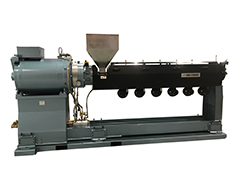Davis-Standard Announces First Quarter R&D Additions
- Published: February 05, 2019
T he Davis-Standard Technical Center has announced two additions to its lab capabilities in Pawcatuck, Conn. By the end of the first quarter, Davis-Standard plans to offer trials for its Davis-Standard Helibar® groove feed extruder and the DS Activ-Check control system for continuous extruder monitoring.
he Davis-Standard Technical Center has announced two additions to its lab capabilities in Pawcatuck, Conn. By the end of the first quarter, Davis-Standard plans to offer trials for its Davis-Standard Helibar® groove feed extruder and the DS Activ-Check control system for continuous extruder monitoring.
“These technologies have been proven in the field and we’re pleased to offer experimentation in our technical center,” said John Christiano, Davis-Standard’s vice president of extrusion technology. “We are firm believers in partnering with customers to make processes better and in maximizing their capital investments. I am eager for customers to use both the Helibar and Activ-Check in establishing performance baselines during real-world trials.”
The Helibar extruder is the next generation in Davis-Standard’s groove feed extruder offering. The dimensions of the extruder in the lab will be 65mm with a 36:1 L/D. With the Helibar design, helical grooves inside the barrel run along the entire barrel bore. This technology has shown to increase extruder output rates while improving energy efficiency and reducing barrel and screw wear. Other advantages include lower start-up costs, shorter residence time and the ability to process higher levels of regrind.
The DS Activ-Check system will be mounted on a 4.5” (114mm) extruder. Using a continuous monitoring platform, the DS Activ-Check strengthens preventative and predictive maintenance for extruder operation. Operators are able to monitor key mechanical and electrical components of the extruder and gearbox and receive early notification of potential component failure to prevent unscheduled downtime. Users can obtain notifications via e-mail and text and can remotely monitor conditions via smart devices or remote PCs. Users could also benefit from the collection of operational data, leading to cost-cutting opportunities.
“The capability to monitor extrusion line variables such as mechanical and electrical system conditions is essential in order to bring products to market faster. I look forward to customers having the opportunity to test the many advantages of this system for both extrusion and converting processes,” said John Clemens, Davis-Standard’s director of extrusion controls
Both technologies will be available to customers by the end of the first quarter.
For more information, visit www.davis-standard.com.




